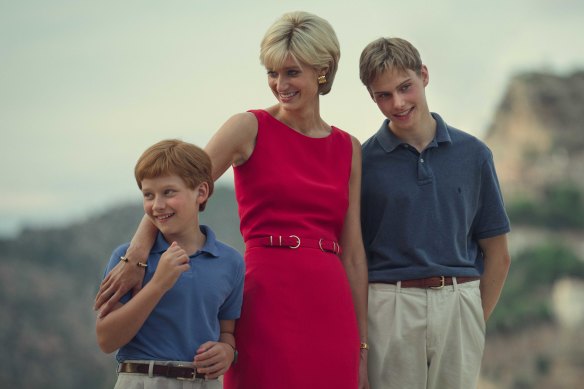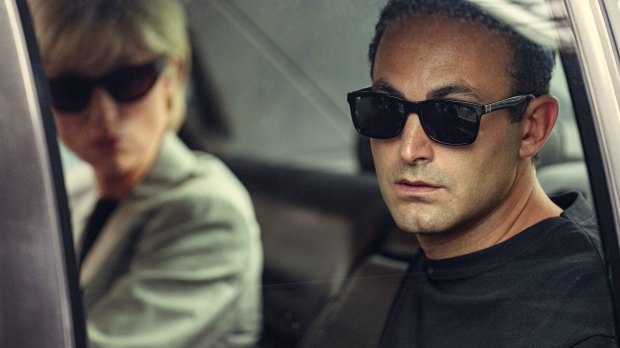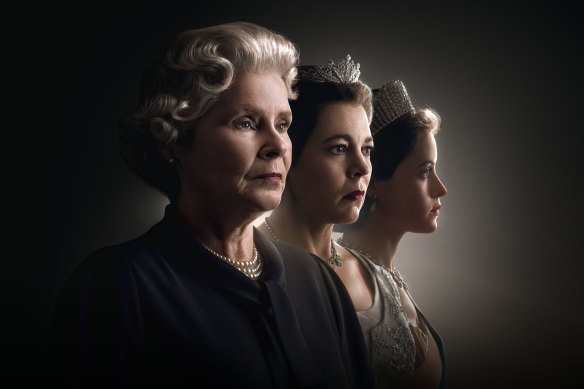Save articles for later
Add articles to your saved list and come back to them any time.
The Crown: Season 6, Part 1
Netflix, on demand
★★★½
“Momentum is with us, opinion has changed, the battle is practically won,” Prince Charles (Dominic West) ponders, as he surveys the shifting political fortunes of his future wife, Camilla Parker-Bowles (Olivia Williams), in the penultimate chapter of The Crown.
This particular piece of the larger mosaic – the four hours that make up season six, part one – of The Crown lands solidly. But the story threads are almost too well known: the complex optics of Camilla’s 50th birthday (and the Queen’s non-attendance), the simmering romance between Diana (Elizabeth Debicki) and Dodi Al-Fayed (Khalid Abdalla) and the final eight weeks of Diana’s life.
Diana (Elizabeth Debicki) with Prince William (Rufus Kampa) and Prince Harry (Fflyn Edwards) in The Crown.Credit: Netflix
The most interesting twist in the tale: that creator/writer Peter Morgan effectively re-dramatises the last of those, rather than creating a natural gap in the final season of The Crown to insert his earlier masterwork, the 2006 film The Queen, which starred Helen Mirren, and explored elegantly and surgically the devastating aftermath of Diana’s death.
Casting an eye across the larger canvas, however, there are deeper problems. The mystique that shrouded the first seasons of The Crown, in part thanks to the smaller volume of historical film from the era, gave it a greater sense of being unknown to the audience. The more recent seasons play like they are ripped from the headlines, which of course they are.
It wouldn’t be so bad, but The Crown must also share the stage with the show’s still performing real-life counterparts: the woe-is-us refugee royals Harry and Meghan, the quaintly eccentric Charles and Camilla and the unmatched outpouring of grief that came in the wake of Queen Elizabeth II’s death.
Diana (Elizabeth Debicki) and Dodi (Khalid Abdalla) in The Crown.Credit: Netflix
It is a problem, too, that The Crown never delved deeply enough into its best, least familiar asset: the pantheon of bit-players who populate the fringes of the royal soap opera. In the show’s earliest seasons, we got the near-Machiavellian Tommy Lascelles, Victoria Hamilton’s magnificently nuanced Queen Mother and Eileen Atkins’s formidable Queen Mary.
But there was no Princess Michael of Kent, no Princess Alexandra, barely a glimpse of the Duchess of York and by a long measure not enough Princess Anne, particularly during Erin Doherty’s spell as Anne in her young adulthood. (One exception: Gillian Anderson’s stunning turn as Maggie Thatcher in season four.)
Instead, the show delves too deeply into the media-worn story of Charles and Diana, pushing even the Queen (Imelda Staunton) and Princess Margaret (Lesley Manville) into the role of bit players, without offering much more than the multitude of telemovies on the same topic, other than casting Dodi Al-Fayed as a barely willing groom-to-be and his father, Mohamed (Salim Daw), in a dubious twist of the historical record, as their matchmaker.
Season six, part one comes with all the scale of past seasons of The Crown, but the pieces of the jigsaw fit awkwardly. The romance of Diana and Dodi might have sold tabloid magazines, but the fate of the crown never rested on its outcome. Which makes the season opener seem like it’s forgotten that the crown itself, and not Diana, is number one on the show’s call sheet.
Three queens: Imelda Staunton, Olivia Colman and Claire Foy from The Crown.Credit: Netflix
Equally frustrating is that Morgan’s casting of the monarch feels like it has matured as unevenly. Claire Foy, who starred in seasons one and two, bore no actual resemblance to the late Queen, but met the audience’s uncertain memories of the younger Elizabeth with a chin-up-and-steely-faced manner that created a rare television sleight of hand. Her two replacements, Olivia Colman and Imelda Staunton, have had to play the part against the audience’s established knowledge of them both as actresses in a multitude of prior roles.
The Crown has also suffered from the same kind of evolutionary change that has worn the actual monarchy from thick with intrigue to thin and often unremarkable. In the 1950s, when the story of The Crown began, the monarchy’s relationship with Britain’s political machinery was more complex and mysterious, played in shadows and whispers.
That complex (and sometimes usefully imperfect) parallel allowed The Crown to dance through chapters of modern political history with a sharp eye for small details, elevating some of the lesser players, such as John Lithgow’s Winston Churchill, Alex Jennings’s Duke of Windsor and Jason Watkins’s Harold Wilson, to the most fascinating pieces on the chessboard.
In its modern iteration, however, the royal family is more garden variety soap opera than political thriller, and the show’s storytelling hems too closely to the established media script instead of the untold (or at least, seemingly untold) political backroom plays which supersized it initially from mere streaming telenovela to genuine blue-chip drama.
The Crown, season six, episodes one to four are streaming on Netflix; episodes five to 10 will be released on December 14.
Find out the next TV, streaming series and movies to add to your must-sees. Get The Watchlist delivered every Thursday.
Most Viewed in Culture
From our partners
Source: Read Full Article



